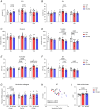Cardiovascular outcome in 12-month-old male and female offspring of metformin-treated obese mice
- PMID: 40538089
- PMCID: PMC12400794
- DOI: 10.1113/JP288696
Cardiovascular outcome in 12-month-old male and female offspring of metformin-treated obese mice
Abstract
Metformin is increasingly used to treat diabetes in pregnancy, but the effects on adult offspring health remain under-explored. The present study investigated the long-term cardiovascular effects in male and female offspring of maternal metformin treatment using a well-established mouse model of obese glucose intolerant pregnancy. Female mice were given chow, or an obesogenic diet with/without 300 mg kg-1 day-1 oral metformin during gestation. At 3, 6 and 12 months of age, male and female offspring were studied longitudinally with tail-cuff plethysmography and echocardiography. At 12 months, tissues were collected for wire myography, histology and molecular analyses. Female offspring of obese dams had elevated blood pressure throughout life, cardiac diastolic dysfunction at 3 months, and increased femoral vasoconstrictor reactivity and aortic wall remodelling at 12 months. Metformin treatment did not ameliorate these effects and led to obesity-induced hypertension at 12 months. Irrespective of metformin, male offspring of obese pregnancy had cardiac diastolic dysfunction from 6 months without changes in blood pressure. Male metformin-exposed offspring also showed cardiomegaly, increased cardiac collagen and vascular sympathetic hyperreactivity, suggesting metformin exposure worsened the cardiovascular phenotype. These findings show that maternal obesity caused sex-specific cardiovascular aberrations in aged offspring. Maternal metformin was not corrective and introduced further sex-dependent cardiovascular alterations. Further long-term offspring follow up of both sexes is needed for informed decisions about metformin during pregnancy. KEY POINTS: The oral medication metformin is increasingly used to treat diabetes in pregnancy. Metformin readily crosses the placenta, and long-term effects on offspring cardiovascular health remain unexplored in human and animal studies. In a mouse model of maternal diet-induced obesity with impaired glucose tolerance, female and male offspring developed hypertension and diastolic cardiac dysfunction, respectively, by 12 months of age (equivalent to middle age in humans). Maternal metformin treatment worsened the cardiovascular phenotype and introduced further sex-dependent cardiovascular alterations in both male (cardiac stiffening, vascular dysfunction) and female (obesity-induced hypertension) offspring. This work highlights that long-term cardiovascular follow up in offspring of both sexes from human pregnancies treated with metformin is crucial to make more informed decisions about metformin use in diabetic pregnancy.
Keywords: cardiac function; gestational diabetes mellitus; hypertension; metformin.
© 2025 The Author(s). The Journal of Physiology published by John Wiley & Sons Ltd on behalf of The Physiological Society.
Conflict of interest statement
The authors declare that there are no relationships or activities that might bias, or be perceived to bias, their work.
Figures





References
-
- Aiken, C. E. & Ozanne, S. E. (2013). Sex differences in developmental programming models. Reproduction (Cambridge, England), 145(1), R1–R13. - PubMed
-
- Bankhead, P. , Loughrey, M. B. , Fernández, J. A. , Dombrowski, Y. , McArt, D. G. , Dunne, P. D. , McQuaid, S. , Gray, R. T. , Murray, L. J. , Coleman, H. G. , James, J. A. , Salto‐Tellez, M. & Hamilton, P. W. (2017). QuPath: Open source software for digital pathology image analysis. Scientific Reports, 7(1), 16878. - PMC - PubMed
-
- Beeson, J. H. , Blackmore, H. L. , Carr, S. K. , Dearden, L. , Duque‐Guimarães, D. E. , Kusinski, L. C. , Pantaleão, L. C. , Pinnock, A. G. , Aiken, C. E. , Giussani, D. A. , Fernandez‐Twinn, D. S. , & Ozanne, S. E. (2018). Maternal exercise intervention in obese pregnancy improves the cardiovascular health of the adult male offspring. Molecular Metabolism, 16, 35–44. - PMC - PubMed
-
- Cesta, C. E. , Cohen, J. M. , Pazzagli, L. , Bateman, B. T. , Bröms, G. , Einarsdóttir, K. , Furu, K. , Havard, A. , Heino, A. , Hernandez‐Diaz, S. , Huybrechts, K. F. , Karlstad, Ø. , Kieler, H. , Li, J. , Leinonen, M. K. , Gulseth, H. L. , Tran, D. , Yu, Y. , Zoega, H. , Odsbu, I. (2019). Antidiabetic medication use during pregnancy: An international utilization study. British Medical Journal Open Diabetes Research Care, 7(1), e000759. - PMC - PubMed
MeSH terms
Substances
Grants and funding
LinkOut - more resources
Full Text Sources
Medical
